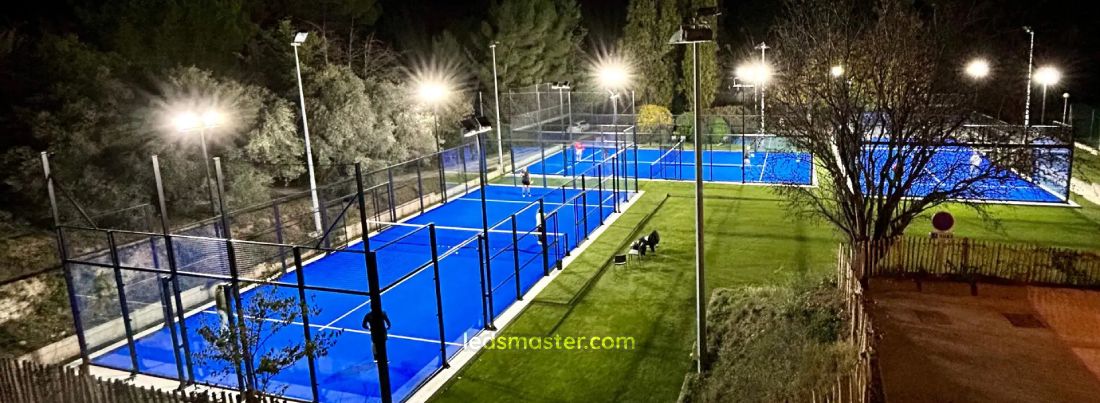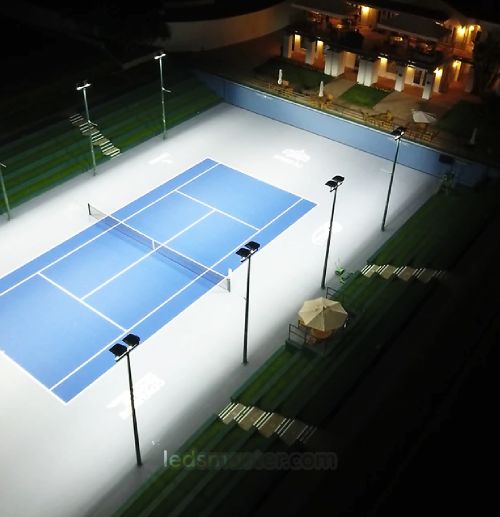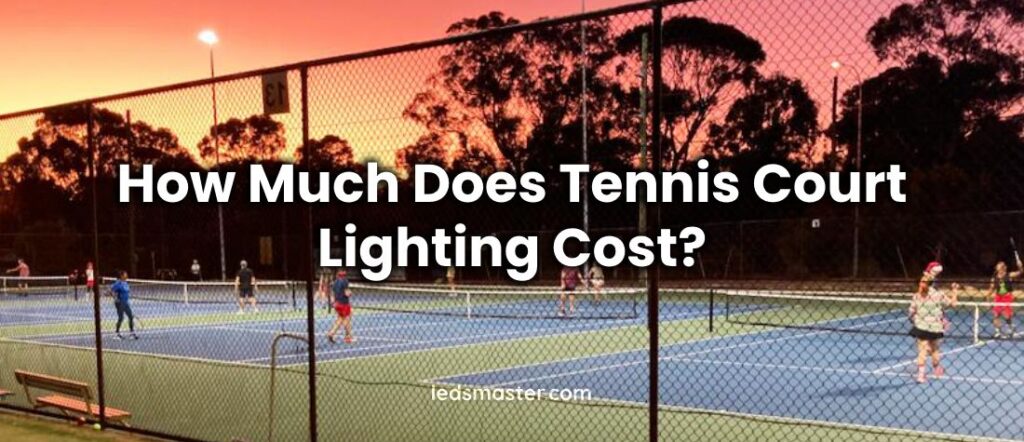The cost of installing tennis court lighting varies widely depending on factors such as the type of lighting system, court size, and installation complexity. This article provides a detailed overview of the costs associated with tennis court lighting, helping you make informed decisions for upgrading or installing a new court.
Table of Contents
ToggleTennis Court Lighting Cost Breakdown
The overall cost of installing tennis court lighting involves several components, including fixture costs, installation, electrical work, and maintenance.
| Cost Component | Description |
|---|---|
| Fixture Costs | The cost of the lighting fixtures themselves. |
| Metal Halide (MH) | $200 – $500 per fixture |
| High-Pressure Sodium (HPS) | $150 – $400 per fixture |
| LED | $400 – $800 per fixture |
| Fluorescent | $100 – $300 per fixture |
| Installation Costs | $2,000 – $5,000 |
| Electrical Work | $1,000 – $3,000 |
| Maintenance Costs | Recurring costs for maintaining and repairing the lighting system. |
| LED | $200 – $500 annually |
| HID and Fluorescent | $500 – $1,000 annually |
Installing lighting for a tennis court is a multifaceted process involving several key components, each contributing to the overall cost. To budget accurately and make informed decisions, it’s crucial to understand these components in detail. The total cost of installing tennis court lighting is determined by a combination of factors including fixture costs, installation expenses, electrical work, and ongoing maintenance.
Fixture Costs
The choice of lighting fixtures impacts the initial investment considerably. The price of tennis court lighting fixtures varies widely based on the type of lighting technology used. For example, Metal Halide fixtures typically cost between $200 and $500 per unit. These fixtures are known for their high brightness and are often used for their ability to provide clear visibility. High-Pressure Sodium fixtures, another common choice, range from $150 to $400 per unit. These lights offer greater energy efficiency and have a longer lifespan compared to Metal Halide lights, although their color rendering is less accurate.
LED fixtures, which are increasingly preferred for their efficiency and long lifespan, generally cost between $400 and $800 per unit. Although the initial expense is higher, LEDs offer significant benefits in terms of energy savings and reduced maintenance. Fluorescent fixtures, which are less common for tennis courts but can be suitable for smaller or recreational settings, are more affordable, typically costing between $100 and $300 per unit. The total fixture cost will be influenced by the number of lights needed to adequately cover the court, based on its size and the desired level of illumination.

Installation Costs
Installation costs cover the professional services required to set up the lighting system. This includes not only the physical mounting of the fixtures but also necessary adjustments to ensure optimal performance and coverage. The complexity of the installation can vary depending on the existing infrastructure and the type of lighting system chosen. For instance, installing Metal Halide or High-Pressure Sodium lights might involve a more extensive setup due to their specific mounting and wiring requirements. On average, installation costs can range from $2,000 to $5,000. This range reflects the need for skilled labor, specialized equipment, and the time required to complete the installation properly.
The installation process also includes aligning and adjusting fixtures to ensure even coverage and effective lighting. Complexities in installation can arise from factors such as existing structures, site conditions, and the specific requirements of the lighting system. Professional installers must ensure that the lighting meets safety standards and provides the appropriate level of illumination for the tennis court.
Electrical Work
This encompasses running electrical lines to power the fixtures, setting up control systems, and ensuring that all electrical connections are safe and compliant with local regulations. The complexity of the electrical work depends on the existing setup and the type of lighting system being installed. For example, LED lights may require specialized wiring or additional control systems to manage their operation effectively.
Electrical work costs typically range from $1,000 to $3,000. This range includes the labor and materials required to integrate the lighting system into the court’s infrastructure. Proper electrical work is essential to ensure that the system operates safely and efficiently. It involves not only connecting the fixtures to the power source but also installing control systems such as timers or dimmers, which can enhance the functionality of the lighting system.
Maintenance Costs
Regular maintenance ensures that the lighting system remains functional and efficient over time. This includes tasks such as replacing bulbs, checking electrical connections, and addressing any wear and tear on the fixtures.
Different lighting technologies have varying maintenance needs. For example, LED lights generally require less frequent maintenance but may still need occasional servicing. The annual cost for maintaining LED fixtures can range from $200 to $500. In contrast, Metal Halide and High-Pressure Sodium lights, due to their shorter lifespans and the need for more frequent bulb replacements, can incur higher maintenance costs. Annual maintenance for these types of fixtures can range from $500 to $1,000. Regular maintenance helps to extend the lifespan of the lighting system and ensures consistent performance.
Additional Costs and Considerations
| Additional Costs | Description | Estimated Cost |
|---|---|---|
| Light Poles and Fixtures | Costs for light poles and mounting hardware. | $500 – $1,500 per pole |
| Lighting Design | Professional design to ensure optimal illumination. | $500 – $2,000 |
| Permits and Regulations | Costs for obtaining necessary permits and approvals. | $200 – $1,000 |
| Energy Costs | Ongoing costs for powering the lighting system. | $500 – $1,500 annually (LED) $1,000 – $3,000 annually (HID or Fluorescent) |
Light Poles and Fixtures
To ensure the proper support and stability of the lighting system, light poles and mounting hardware are essential. The costs for these components typically range from $500 to $1,500 per pole. This range reflects the need for durable and robust poles designed to bear the weight of the lighting fixtures and withstand environmental conditions. Factors such as the material of the poles, their height, and any specialized features like coatings or finishes will influence the final cost. Investing in quality light poles is crucial to ensure the long-term stability and safety of the lighting system.
Lighting Design
 Lighting design services are necessary to achieve optimal illumination across the court. This process involves a thorough analysis of the court’s dimensions, the strategic placement and angling of fixtures, and the calculation of light levels to ensure even coverage without shadows or glare. The cost for these design services generally ranges from $500 to $2,000. While this might seem like a significant investment, professional design ensures that the lighting system will meet the specific needs of the court, enhancing visibility and the playing experience.
Lighting design services are necessary to achieve optimal illumination across the court. This process involves a thorough analysis of the court’s dimensions, the strategic placement and angling of fixtures, and the calculation of light levels to ensure even coverage without shadows or glare. The cost for these design services generally ranges from $500 to $2,000. While this might seem like a significant investment, professional design ensures that the lighting system will meet the specific needs of the court, enhancing visibility and the playing experience.
Despite this expense, some lighting companies, including ours, are willing to offer lighting design services at no additional cost. This can provide substantial savings and ensure you receive expert guidance without further financial commitment.
Permits and Regulations
Permits and Regulations involve costs associated with complying with local codes and obtaining necessary approvals. Before installation, securing the required permits and approvals is essential to ensure that the lighting system adheres to legal standards and safety regulations. These administrative costs can range from $200 to $1,000. This expense includes the fees for submitting plans, undergoing inspections, and fulfilling any other regulatory requirements. Complying with local regulations is crucial to prevent potential fines, delays, or issues with the installation process, as well as to ensure that the lighting system operates safely and within legal boundaries.
Energy Costs
Energy Costs are an ongoing consideration that affects the long-term financial commitment of operating a tennis court lighting system. The annual cost of powering the lighting system varies based on the type of lighting technology used. For LED lights, which are known for their energy efficiency, the annual energy costs typically range from $500 to $1,500. In contrast, High-Intensity Discharge (HID) and fluorescent lights, which consume more power, result in higher energy expenses, generally ranging from $1,000 to $3,000 annually. These ongoing costs should be factored into the overall budget, as they can significantly impact the total cost of ownership over time. Choosing energy-efficient lighting options can help reduce these expenses and contribute to long-term savings.
Total Cost Estimate
Here’s a breakdown of the estimated total costs for a standard tennis court (excluding land preparation and court surface costs).
| Lighting Type | Fixtures (6-8 units) | Installation | Electrical Work | Maintenance (Annual) | Total Initial Cost | Total Annual Energy Cost |
|---|---|---|---|---|---|---|
| Metal Halide (MH) | $1,200 – $4,000 | $2,000 – $5,000 | $1,000 – $3,000 | $500 – $1,000 | $4,200 – $12,000 | $1,000 – $3,000 |
| High-Pressure Sodium (HPS) | $1,200 – $3,200 | $2,000 – $5,000 | $1,000 – $3,000 | $500 – $1,000 | $4,200 – $11,200 | $1,000 – $3,000 |
| LED | $2,400 – $6,400 | $2,500 – $5,000 | $1,000 – $3,000 | $200 – $500 | $5,900 – $14,400 | $500 – $1,500 |
| Fluorescent | $600 – $2,400 | $2,000 – $5,000 | $1,000 – $3,000 | $500 – $1,000 | $3,600 – $10,400 | $1,000 – $3,000 |
Conclusion
The cost of installing tennis court lighting can vary based on the type of lighting system, installation complexity, and additional factors. While LED lights may have a higher initial cost, they offer long-term benefits such as lower energy consumption and maintenance costs. HID and fluorescent lights may have lower upfront costs but could result in higher ongoing expenses. By evaluating your needs and budget, you can choose a lighting solution that enhances your tennis court and provides value over time.

